Yong Ren
Step-Audio 2 Technical Report
Jul 24, 2025Abstract:This paper presents Step-Audio 2, an end-to-end multi-modal large language model designed for industry-strength audio understanding and speech conversation. By integrating a latent audio encoder and reasoning-centric reinforcement learning (RL), Step-Audio 2 achieves promising performance in automatic speech recognition (ASR) and audio understanding. To facilitate genuine end-to-end speech conversation, Step-Audio 2 incorporates the generation of discrete audio tokens into language modeling, significantly enhancing its responsiveness to paralinguistic information such as speaking styles and emotions. To effectively leverage the rich textual and acoustic knowledge in real-world data, Step-Audio 2 integrates retrieval-augmented generation (RAG) and is able to call external tools such as web search to mitigate hallucination and audio search to switch timbres. Trained on millions of hours of speech and audio data, Step-Audio 2 delivers intelligence and expressiveness across diverse conversational scenarios. Evaluation results demonstrate that Step-Audio 2 achieves state-of-the-art performance on various audio understanding and conversational benchmarks compared to other open-source and commercial solutions. Please visit https://github.com/stepfun-ai/Step-Audio2 for more information.
Mitigating Audiovisual Mismatch in Visual-Guide Audio Captioning
May 28, 2025Abstract:Current vision-guided audio captioning systems frequently fail to address audiovisual misalignment in real-world scenarios, such as dubbed content or off-screen sounds. To bridge this critical gap, we present an entropy-aware gated fusion framework that dynamically modulates visual information flow through cross-modal uncertainty quantification. Our novel approach employs attention entropy analysis in cross-attention layers to automatically identify and suppress misleading visual cues during modal fusion. Complementing this architecture, we develop a batch-wise audiovisual shuffling technique that generates synthetic mismatched training pairs, greatly enhancing model resilience against alignment noise. Evaluations on the AudioCaps benchmark demonstrate our system's superior performance over existing baselines, especially in mismatched modality scenarios. Furthermore, our solution demonstrates an approximately 6x improvement in inference speed compared to the baseline.
Information-Theoretic Complementary Prompts for Improved Continual Text Classification
May 27, 2025Abstract:Continual Text Classification (CTC) aims to continuously classify new text data over time while minimizing catastrophic forgetting of previously acquired knowledge. However, existing methods often focus on task-specific knowledge, overlooking the importance of shared, task-agnostic knowledge. Inspired by the complementary learning systems theory, which posits that humans learn continually through the interaction of two systems -- the hippocampus, responsible for forming distinct representations of specific experiences, and the neocortex, which extracts more general and transferable representations from past experiences -- we introduce Information-Theoretic Complementary Prompts (InfoComp), a novel approach for CTC. InfoComp explicitly learns two distinct prompt spaces: P(rivate)-Prompt and S(hared)-Prompt. These respectively encode task-specific and task-invariant knowledge, enabling models to sequentially learn classification tasks without relying on data replay. To promote more informative prompt learning, InfoComp uses an information-theoretic framework that maximizes mutual information between different parameters (or encoded representations). Within this framework, we design two novel loss functions: (1) to strengthen the accumulation of task-specific knowledge in P-Prompt, effectively mitigating catastrophic forgetting, and (2) to enhance the retention of task-invariant knowledge in S-Prompt, improving forward knowledge transfer. Extensive experiments on diverse CTC benchmarks show that our approach outperforms previous state-of-the-art methods.
Hearing from Silence: Reasoning Audio Descriptions from Silent Videos via Vision-Language Model
May 19, 2025Abstract:Humans can intuitively infer sounds from silent videos, but whether multimodal large language models can perform modal-mismatch reasoning without accessing target modalities remains relatively unexplored. Current text-assisted-video-to-audio (VT2A) methods excel in video foley tasks but struggle to acquire audio descriptions during inference. We introduce the task of Reasoning Audio Descriptions from Silent Videos (SVAD) to address this challenge and investigate vision-language models' (VLMs) capabilities on this task. To further enhance the VLMs' reasoning capacity for the SVAD task, we construct a CoT-AudioCaps dataset and propose a Chain-of-Thought-based supervised fine-tuning strategy. Experiments on SVAD and subsequent VT2A tasks demonstrate our method's effectiveness in two key aspects: significantly improving VLMs' modal-mismatch reasoning for SVAD and effectively addressing the challenge of acquiring audio descriptions during VT2A inference.
$\mathcal{A}LLM4ADD$: Unlocking the Capabilities of Audio Large Language Models for Audio Deepfake Detection
May 16, 2025Abstract:Audio deepfake detection (ADD) has grown increasingly important due to the rise of high-fidelity audio generative models and their potential for misuse. Given that audio large language models (ALLMs) have made significant progress in various audio processing tasks, a heuristic question arises: Can ALLMs be leveraged to solve ADD?. In this paper, we first conduct a comprehensive zero-shot evaluation of ALLMs on ADD, revealing their ineffectiveness in detecting fake audio. To enhance their performance, we propose $\mathcal{A}LLM4ADD$, an ALLM-driven framework for ADD. Specifically, we reformulate ADD task as an audio question answering problem, prompting the model with the question: "Is this audio fake or real?". We then perform supervised fine-tuning to enable the ALLM to assess the authenticity of query audio. Extensive experiments are conducted to demonstrate that our ALLM-based method can achieve superior performance in fake audio detection, particularly in data-scarce scenarios. As a pioneering study, we anticipate that this work will inspire the research community to leverage ALLMs to develop more effective ADD systems.
Region-Based Optimization in Continual Learning for Audio Deepfake Detection
Dec 16, 2024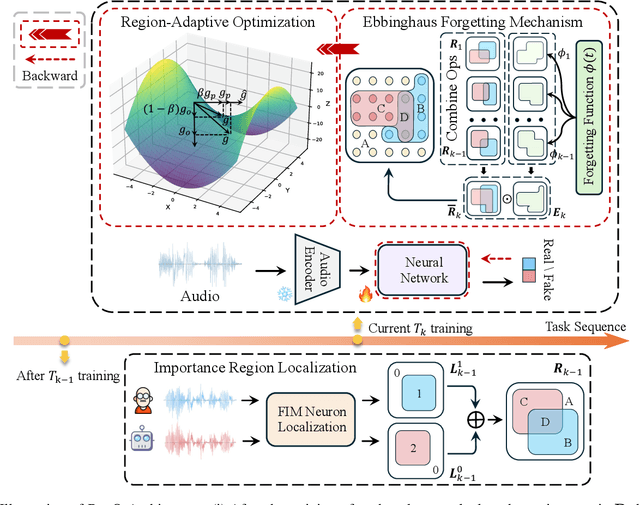
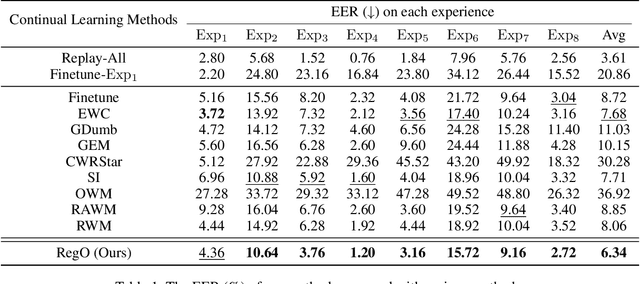

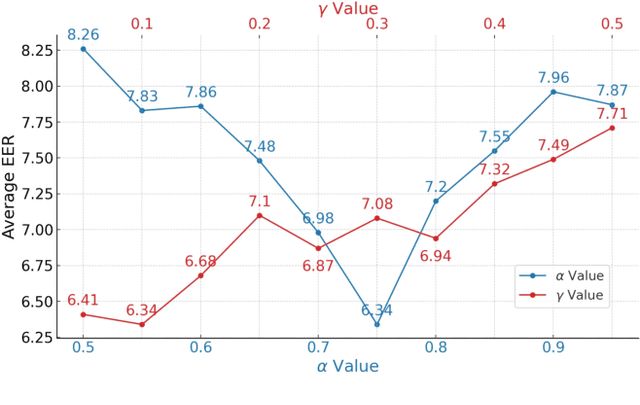
Abstract:Rapid advancements in speech synthesis and voice conversion bring convenience but also new security risks, creating an urgent need for effective audio deepfake detection. Although current models perform well, their effectiveness diminishes when confronted with the diverse and evolving nature of real-world deepfakes. To address this issue, we propose a continual learning method named Region-Based Optimization (RegO) for audio deepfake detection. Specifically, we use the Fisher information matrix to measure important neuron regions for real and fake audio detection, dividing them into four regions. First, we directly fine-tune the less important regions to quickly adapt to new tasks. Next, we apply gradient optimization in parallel for regions important only to real audio detection, and in orthogonal directions for regions important only to fake audio detection. For regions that are important to both, we use sample proportion-based adaptive gradient optimization. This region-adaptive optimization ensures an appropriate trade-off between memory stability and learning plasticity. Additionally, to address the increase of redundant neurons from old tasks, we further introduce the Ebbinghaus forgetting mechanism to release them, thereby promoting the capability of the model to learn more generalized discriminative features. Experimental results show our method achieves a 21.3% improvement in EER over the state-of-the-art continual learning approach RWM for audio deepfake detection. Moreover, the effectiveness of RegO extends beyond the audio deepfake detection domain, showing potential significance in other tasks, such as image recognition. The code is available at https://github.com/cyjie429/RegO
Is FISHER All You Need in The Multi-AUV Underwater Target Tracking Task?
Dec 05, 2024



Abstract:It is significant to employ multiple autonomous underwater vehicles (AUVs) to execute the underwater target tracking task collaboratively. However, it's pretty challenging to meet various prerequisites utilizing traditional control methods. Therefore, we propose an effective two-stage learning from demonstrations training framework, FISHER, to highlight the adaptability of reinforcement learning (RL) methods in the multi-AUV underwater target tracking task, while addressing its limitations such as extensive requirements for environmental interactions and the challenges in designing reward functions. The first stage utilizes imitation learning (IL) to realize policy improvement and generate offline datasets. To be specific, we introduce multi-agent discriminator-actor-critic based on improvements of the generative adversarial IL algorithm and multi-agent IL optimization objective derived from the Nash equilibrium condition. Then in the second stage, we develop multi-agent independent generalized decision transformer, which analyzes the latent representation to match the future states of high-quality samples rather than reward function, attaining further enhanced policies capable of handling various scenarios. Besides, we propose a simulation to simulation demonstration generation procedure to facilitate the generation of expert demonstrations in underwater environments, which capitalizes on traditional control methods and can easily accomplish the domain transfer to obtain demonstrations. Extensive simulation experiments from multiple scenarios showcase that FISHER possesses strong stability, multi-task performance and capability of generalization.
Reject Threshold Adaptation for Open-Set Model Attribution of Deepfake Audio
Dec 02, 2024

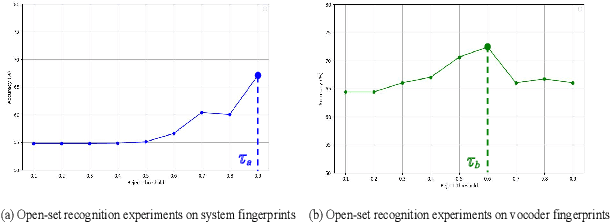

Abstract:Open environment oriented open set model attribution of deepfake audio is an emerging research topic, aiming to identify the generation models of deepfake audio. Most previous work requires manually setting a rejection threshold for unknown classes to compare with predicted probabilities. However, models often overfit training instances and generate overly confident predictions. Moreover, thresholds that effectively distinguish unknown categories in the current dataset may not be suitable for identifying known and unknown categories in another data distribution. To address the issues, we propose a novel framework for open set model attribution of deepfake audio with rejection threshold adaptation (ReTA). Specifically, the reconstruction error learning module trains by combining the representation of system fingerprints with labels corresponding to either the target class or a randomly chosen other class label. This process generates matching and non-matching reconstructed samples, establishing the reconstruction error distributions for each class and laying the foundation for the reject threshold calculation module. The reject threshold calculation module utilizes gaussian probability estimation to fit the distributions of matching and non-matching reconstruction errors. It then computes adaptive reject thresholds for all classes through probability minimization criteria. The experimental results demonstrate the effectiveness of ReTA in improving the open set model attributes of deepfake audio.
Evaluating Large Language Models on Financial Report Summarization: An Empirical Study
Nov 11, 2024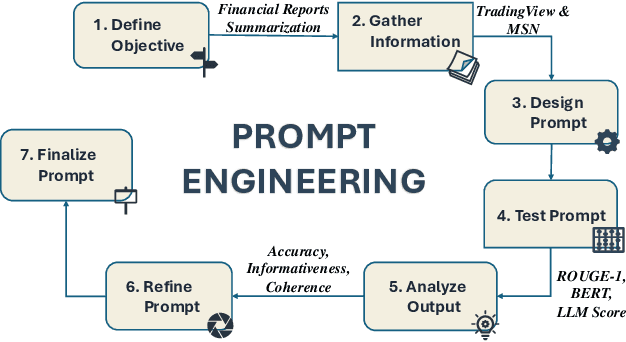
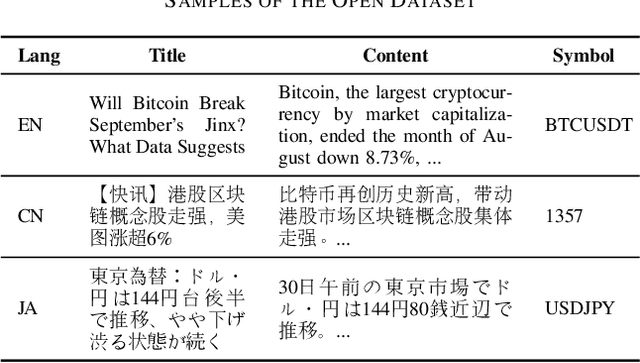
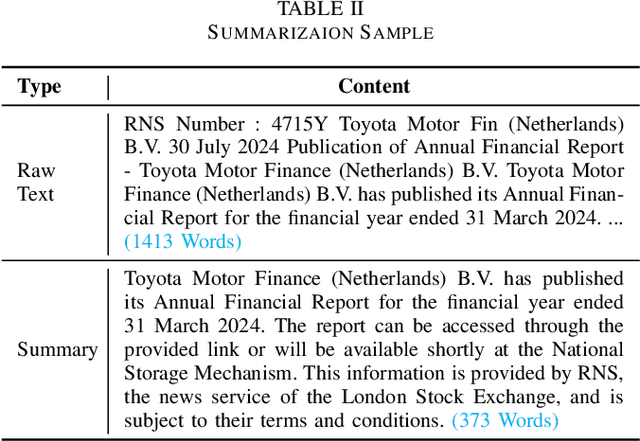
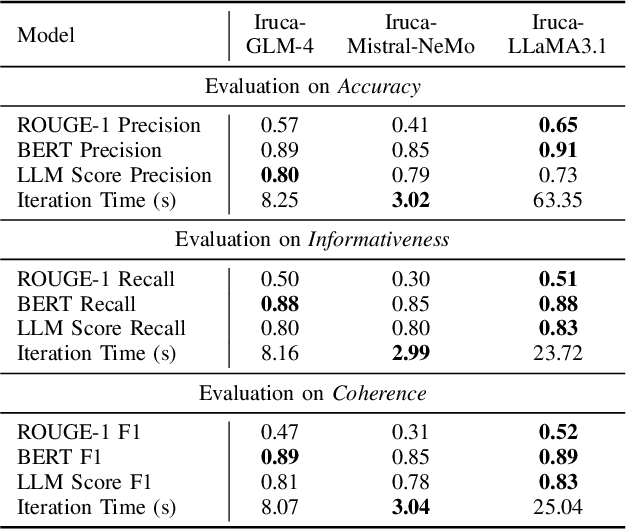
Abstract:In recent years, Large Language Models (LLMs) have demonstrated remarkable versatility across various applications, including natural language understanding, domain-specific knowledge tasks, etc. However, applying LLMs to complex, high-stakes domains like finance requires rigorous evaluation to ensure reliability, accuracy, and compliance with industry standards. To address this need, we conduct a comprehensive and comparative study on three state-of-the-art LLMs, GLM-4, Mistral-NeMo, and LLaMA3.1, focusing on their effectiveness in generating automated financial reports. Our primary motivation is to explore how these models can be harnessed within finance, a field demanding precision, contextual relevance, and robustness against erroneous or misleading information. By examining each model's capabilities, we aim to provide an insightful assessment of their strengths and limitations. Our paper offers benchmarks for financial report analysis, encompassing proposed metrics such as ROUGE-1, BERT Score, and LLM Score. We introduce an innovative evaluation framework that integrates both quantitative metrics (e.g., precision, recall) and qualitative analyses (e.g., contextual fit, consistency) to provide a holistic view of each model's output quality. Additionally, we make our financial dataset publicly available, inviting researchers and practitioners to leverage, scrutinize, and enhance our findings through broader community engagement and collaborative improvement. Our dataset is available on huggingface.
WMCodec: End-to-End Neural Speech Codec with Deep Watermarking for Authenticity Verification
Sep 18, 2024
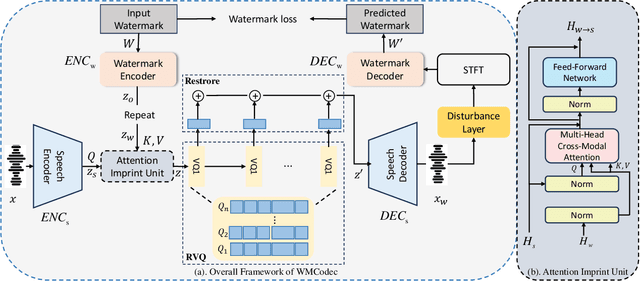


Abstract:Recent advances in speech spoofing necessitate stronger verification mechanisms in neural speech codecs to ensure authenticity. Current methods embed numerical watermarks before compression and extract them from reconstructed speech for verification, but face limitations such as separate training processes for the watermark and codec, and insufficient cross-modal information integration, leading to reduced watermark imperceptibility, extraction accuracy, and capacity. To address these issues, we propose WMCodec, the first neural speech codec to jointly train compression-reconstruction and watermark embedding-extraction in an end-to-end manner, optimizing both imperceptibility and extractability of the watermark. Furthermore, We design an iterative Attention Imprint Unit (AIU) for deeper feature integration of watermark and speech, reducing the impact of quantization noise on the watermark. Experimental results show WMCodec outperforms AudioSeal with Encodec in most quality metrics for watermark imperceptibility and consistently exceeds both AudioSeal with Encodec and reinforced TraceableSpeech in extraction accuracy of watermark. At bandwidth of 6 kbps with a watermark capacity of 16 bps, WMCodec maintains over 99% extraction accuracy under common attacks, demonstrating strong robustness.
 Add to Chrome
Add to Chrome Add to Firefox
Add to Firefox Add to Edge
Add to Edge